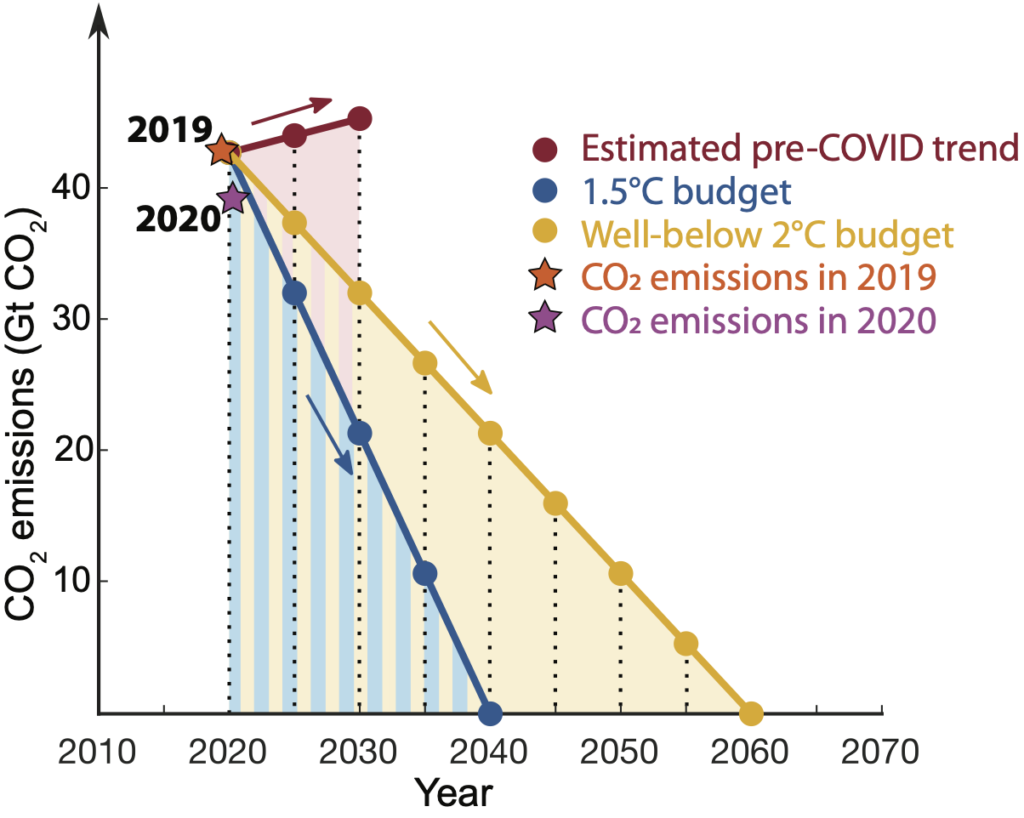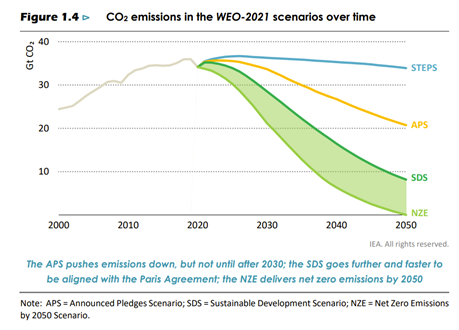It is clear that if carbon dioxide emissions continue to rise, that global temperature will continue to rise (see the section on global temperatures). In fact, there is an approximately linear relationship between cumulative CO2 emissions and the warming effect they have on the planet (Tokarska and Matthews, Carbon Brief, 19 January 2021 [https://www.carbonbrief.org/guest-post-refining-the-remaining-1-5c-carbon-budget]).
This relationship is described as the Transient Climate Response to Cumulative Emissions (TCRE) by the authors. And while other factors affect TCRE, such as the scale of anthropogenic warming thus far, total historical CO2 emissions, and the relative warming effects of CO2 and non-CO2 (such as methane and nitrous oxide) emissions, it is possible to estimate TCRE.
The best estimate in 2021 is 0.44°C per 1,000 GtCO2 emitted. Tokarska and Matthews note that this is similar to the estimate of the IPCC in the special report on 1.5°C published in 2018. Using this TCRE, the authors estimate that the remaining carbon emissions budget if we are not to exceed 1.5°C since pre-industrial temperature levels, is 440 GtCO2 from 2020 onwards. Due to the uncertainties mentioned above, this estimate falls within a range of 230-670 GtCO2, which reflects a 33% to 67% chance of not exceeding the target.
 The accompanying graph shows that to achieve the 1.5°C target global net CO2 emissions must decline in a linear fashion to zero by 2040 (blue line). To remain well below 2°C, net emissions must reach zero by 2060 (ibid).
The accompanying graph shows that to achieve the 1.5°C target global net CO2 emissions must decline in a linear fashion to zero by 2040 (blue line). To remain well below 2°C, net emissions must reach zero by 2060 (ibid).
The red star indicates the 2019 level of emissions, and the purple star the 2020 emissions, some 7% lower (see section on Global GHG Emissions – link).
Source: Tokarska and Matthews, Carbon Brief, 19 January 2021
If this declining trend is maintained it would be possible to achieve the 1.5°C target, but as this decline may be temporary, caused by the Covid 19 pandemic, it remains to be seen if such a downward trend can be maintained.
While Tokarska and Matthews state that their estimates are similar to the IPCC AR6 estimates, there is a notable difference. The IPCC AR6 Summary for Policymakers in Table SPM2 (page 33) presents remaining carbon budgets at five different levels of certainty (17%, 33%, 50%, 67%, 83%). At 67% likelihood of achieving the 1.5°C target, the remaining budget is 400 GtCO2. To achieve a 1.7C target the budget is 700 GtCO2, and a 2°C target the budget is 1,150 GtCO2.
More cautious estimates come from the Climate Analytics CONSTRAIN project which concludes that from the start of 2020, the remaining carbon budget to achieve 2°C with a 66% probability is 985 GtCO2, significantly less than the IPCC’s 1,150 GtCO2. To achieve the 1.5°C target with a 50% probability the budget would be 395 Gt CO2 compared to 500 from IPCC, and with a 66% probability, it would be a greatly reduced 235 GtCO2, compared to the previously quoted 400 GtCO2 from IPCC [https://www.climateanalytics.org/publications/ 2019/zero-in-on-the-remaining-carbon-budget-and-decadal-warming-rates/].
Importantly, at current rates of CO2 emissions – some 42.2 GtCO2 per year - the time permitted to consume the 400 GTCO2 budget would be 7 years and 8 months. To achieve the 2°C target the time to consume the permitted 1,150 GtCO2 would be 25 years and 5 months, as of November 2021 according to the Mercator Research Institute on Global Commons and Climate Change [https://www.mcc-berlin.net.en/research/co2-budget.html].
There is a recent modification by ClimateWorksAustralia, based on a 2021 estimate of 1.2°C increase in global temperature since pre-industrial levels. This leaves the remaining CO2 budget at 296 GtCO2. This is 30 percent lower than the 2018 IPCC “Special Report on Global Warming of 1.5°C”. This implies that emissions must follow a linear decrease to zero by 2034 [https://www.climateworksaustralia.org/news/the-global-1-5c-carbon-budget-has-reduced-by-30-per-cent/].
In order to try to achieve these necessary reductions, work is proceeding on the contribution of various sectors of the economy. The University of Technology Sydney (UTS) has estimated for the current 400 GtCO2 budget to be reduced to net zero (around 210 GtCO2 p.a.), that the steel industry would need to reduce by 5.0% or 19 GtCO2. The cement industry by 2.4% or 9 GtCO2. Aluminum industry by 1.6% or 6 GtCO2.The largest sectors include buildings (climatization and electricity) by 22.6% or 88 GtCO2, and road transport by 21.1% or 82 GtCO2 [https://www.unepfi.org/news/themes/climate-change/new-research-identifies-remaining-global-carbon-budget-for-twelve-main-industries/].
This research had been financed in parts by the UN-convened Net-Zero Asset Owner Alliance [https://www.unepfi.org/net-zero-alliance/], the Rockefeller Foundation [https://www.rockefellerfoundation.org/], and the European Climate Foundation (ECF) – [https://europeanclimate.org/]. It is hoped that a sector-focused approach can assist the finance industry in determining its future investments.
Emissions Gap
As mentioned, the estimates of global GHGs vary by source. The UN Environmental Program shows the highest estimate (excluding LULUCF) for 2020 at about 52 GtCO2 eq. If current policies continue, that will rise to about 58.5 . by 2030. If the world follows current unconditional Nationally Determined Contributions (NDC), the 2030 level will likely be 56-57 GtCO2e. If conditional NDCs are followed, the level would be 53-54 GtCO2e.
For the world to follow the trajectory to 1.5°C by mid-century, according to the EGR 2021 report, GHG emissions will need to decline to 25 GtCO2e by 2030 (same as 2020 EGR report), so less than half the level otherwise. If the world follows the 2°C scenario, GHG emissions must decline to 39 GtCO2e, (pessimistically reduced from 41 GtCO2e in the 2020 report) by 2030 (UNEP Emissions Gap Report 2021, Table 4.2, p.35). This assumes following the conditional NDCs and 50 GtCO2e emissions if the gap is not closed.
Is there a reason for optimism? The International Energy Agency’s World Energy Outlook (WEO) 2021 [https://www.iea.org/reports/world-energy-outlook-2021] suggests that the challenge is substantial. Even if NDCs are enhanced, as after COP26, and combined with net-zero pledges (NZE), in what WEO describes as Announced Pledges Scenario (APS), this will only close less than 20% of the CO2 emissions gap in 2030 between the Stated Policies Scenario (STEPS) and the NZE. This will result in a rise in global temperature (since industrial times) of around 2.1°C by the end of the century.
 So, between the APS and NZE, there is about a 12 GtCO2e gap by 2030 requiring stronger commitments. If, in addition to CO2, methane is also counted then the gap is around 14 GtCO2e.
So, between the APS and NZE, there is about a 12 GtCO2e gap by 2030 requiring stronger commitments. If, in addition to CO2, methane is also counted then the gap is around 14 GtCO2e.
Note: APS= Announced Pledges Scenario; SDS= Sustainable Development Scenario; NZE= Net Zero Emissions by 2050 Scenario.
The WEO issues this ominous warning: “If the world is off course in 2030, it will be extremely difficult to make up lost ground later” (WEO 2021, p.33).
This website was produced with the support of the United States Agency for International Development (USAID) under the terms of USAID's Research for Decision Makers (RDM) Activity cooperative agreement no. AID-388-A-17-00006
Views expressed herein do not necessarily reflect the views of the U.S. Government or USAID. icddr,b is also grateful to the Governments of Bangladesh, Canada, Sweden and the UK for providing unrestricted/institutional support
68, Shaheed Tajuddin Ahmed Sarani Mohakhali, Dhaka 1212, Bangladesh
icddr,b is located at the Mohakhali area in Dhaka, just ask your driver for the "Cholera Hospital"
